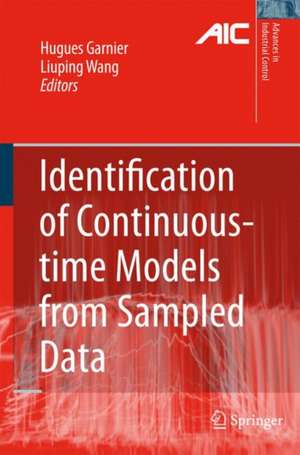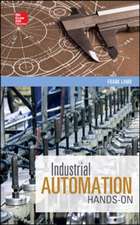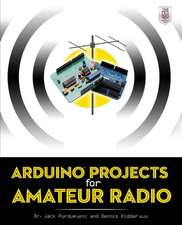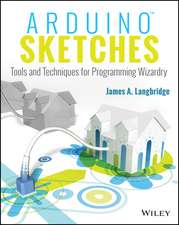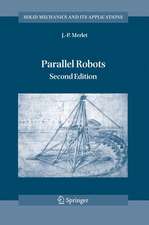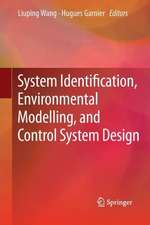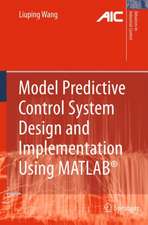Identification of Continuous-time Models from Sampled Data: Advances in Industrial Control
Editat de Hugues Garnier, Liuping Wangen Limba Engleză Hardback – 28 mar 2008
The CONTSID toolbox discussed in the final chapter gives an overview of developments and practical examples in which MATLAB® can be used for direct time-domain identification of continuous-time systems. A valuable reference for a broad audience drawn from researchers and graduate students in signal processing as well as in systems and control this book also covers material suitable for specialised graduate courses in these areas.
| Toate formatele și edițiile | Preț | Express |
|---|---|---|
| Paperback (1) | 1386.92 lei 6-8 săpt. | |
| SPRINGER LONDON – 21 oct 2010 | 1386.92 lei 6-8 săpt. | |
| Hardback (1) | 1393.09 lei 6-8 săpt. | |
| SPRINGER LONDON – 28 mar 2008 | 1393.09 lei 6-8 săpt. |
Din seria Advances in Industrial Control
- 15%
 Preț: 643.34 lei
Preț: 643.34 lei - 23%
 Preț: 582.63 lei
Preț: 582.63 lei - 18%
 Preț: 783.98 lei
Preț: 783.98 lei - 18%
 Preț: 947.35 lei
Preț: 947.35 lei - 20%
 Preț: 568.24 lei
Preț: 568.24 lei - 15%
 Preț: 643.16 lei
Preț: 643.16 lei - 18%
 Preț: 899.21 lei
Preț: 899.21 lei - 18%
 Preț: 891.33 lei
Preț: 891.33 lei - 18%
 Preț: 740.57 lei
Preț: 740.57 lei - 18%
 Preț: 961.23 lei
Preț: 961.23 lei - 18%
 Preț: 955.08 lei
Preț: 955.08 lei - 15%
 Preț: 645.28 lei
Preț: 645.28 lei - 15%
 Preț: 638.43 lei
Preț: 638.43 lei - 18%
 Preț: 901.11 lei
Preț: 901.11 lei - 18%
 Preț: 1410.94 lei
Preț: 1410.94 lei - 18%
 Preț: 728.91 lei
Preț: 728.91 lei - 20%
 Preț: 1003.77 lei
Preț: 1003.77 lei - 18%
 Preț: 947.35 lei
Preț: 947.35 lei - 15%
 Preț: 643.34 lei
Preț: 643.34 lei - 15%
 Preț: 654.30 lei
Preț: 654.30 lei - 18%
 Preț: 950.52 lei
Preț: 950.52 lei - 15%
 Preț: 644.30 lei
Preț: 644.30 lei - 18%
 Preț: 950.21 lei
Preț: 950.21 lei - 18%
 Preț: 949.90 lei
Preț: 949.90 lei - 18%
 Preț: 949.42 lei
Preț: 949.42 lei - 18%
 Preț: 950.52 lei
Preț: 950.52 lei - 18%
 Preț: 1113.71 lei
Preț: 1113.71 lei - 15%
 Preț: 650.04 lei
Preț: 650.04 lei - 15%
 Preț: 644.95 lei
Preț: 644.95 lei - 18%
 Preț: 950.33 lei
Preț: 950.33 lei - 18%
 Preț: 948.61 lei
Preț: 948.61 lei - 18%
 Preț: 1112.60 lei
Preț: 1112.60 lei - 15%
 Preț: 644.63 lei
Preț: 644.63 lei - 18%
 Preț: 953.20 lei
Preț: 953.20 lei - 18%
 Preț: 945.62 lei
Preț: 945.62 lei - 15%
 Preț: 640.88 lei
Preț: 640.88 lei - 15%
 Preț: 640.88 lei
Preț: 640.88 lei - 20%
 Preț: 650.92 lei
Preț: 650.92 lei - 18%
 Preț: 1112.60 lei
Preț: 1112.60 lei - 20%
 Preț: 998.36 lei
Preț: 998.36 lei - 15%
 Preț: 643.34 lei
Preț: 643.34 lei - 18%
 Preț: 948.92 lei
Preț: 948.92 lei - 18%
 Preț: 1381.43 lei
Preț: 1381.43 lei - 15%
 Preț: 651.51 lei
Preț: 651.51 lei - 15%
 Preț: 647.08 lei
Preț: 647.08 lei - 20%
 Preț: 563.66 lei
Preț: 563.66 lei - 18%
 Preț: 998.03 lei
Preț: 998.03 lei - 18%
 Preț: 1225.79 lei
Preț: 1225.79 lei
Preț: 1393.09 lei
Preț vechi: 1698.89 lei
-18% Nou
Puncte Express: 2090
Preț estimativ în valută:
266.60€ • 273.02$ • 221.77£
266.60€ • 273.02$ • 221.77£
Carte tipărită la comandă
Livrare economică 18 martie-01 aprilie
Preluare comenzi: 021 569.72.76
Specificații
ISBN-13: 9781848001602
ISBN-10: 1848001606
Pagini: 440
Ilustrații: XXVI, 413 p.
Dimensiuni: 155 x 235 x 28 mm
Greutate: 0.79 kg
Ediția:2008
Editura: SPRINGER LONDON
Colecția Springer
Seria Advances in Industrial Control
Locul publicării:London, United Kingdom
ISBN-10: 1848001606
Pagini: 440
Ilustrații: XXVI, 413 p.
Dimensiuni: 155 x 235 x 28 mm
Greutate: 0.79 kg
Ediția:2008
Editura: SPRINGER LONDON
Colecția Springer
Seria Advances in Industrial Control
Locul publicării:London, United Kingdom
Public țintă
ResearchCuprins
Direct Identification of Continuous-time Models from Sampled Data: Issues, Basic Solutions and Relevance.- Estimation of Continuous-time Stochastic System Parameters.- Robust Identification of Continuous-time Systems from Sampled Data.- Refined Instrumental Variable Identification of Continuous-time Hybrid Box-Jenkins Models.- Instrumental Variable Methods for Closed-loop Continuous-time Model Identification.- Model Order Identification for Continuous-time Models.- Estimation of the Parameters of Continuous-time Systems Using Data Compression.- Frequency-domain Approach to Continuous-time System Identification: Some Practical Aspects.- The CONTSID Toolbox: A Software Support for Data-based Continuous-time Modelling.- Subspace-based Continuous-time Identification.- Process Parameter and Delay Estimation from Non-uniformly Sampled Data.- Iterative Methods for Identification of Multiple-input Continuous-time Systems with Unknown Time Delays.- Closed-loop Parametric Identification for Continuous-time Linear Systems via New Algebraic Techniques.- Continuous-time Model Identification Using Spectrum Analysis with Passivity-preserving Model Reduction.
Notă biografică
Professor Hugues Garnier was appointed Associate Professor in 1995 at Université Henri Poincaré, Nancy 1. From Sept. 2003 to Aug. 2004, he visited the Centre for Complex Dynamic System and Control, University of Newcastle, Australia. Currently Hugues Garnier is a Professor at Université Henri Poincaré, Nancy 1 where he is the leader of the System Identification Project at the Centre de Recherche en Automatique de Nancy.
He is the co-leader of the French working group on "System identification" of the GdR MACS and is member of the IFAC Technical Committee TC-1.1. Modelling, Identification & Signal Processing. He is also a member of the International Program Committe for the IFAC Symposium on System Identification (SYSID'2006), to be held in Newcastle, Australia in March 2006.
Professor Hugues Garnier's main research interest is related to analysis and modelling of stochastic dynamical systems. This includes signal processing, time series analysis and prediction, parameter estimation and system identification, especially of continuous-time systems. Professor Hugues Garnier has written several recent contributions on new techniques for continuous-time model identification and organised many invited sessions at international congresses (ECC'1999, World IFAC Congresses 2002 and 2005, SYSID'2003, SYSID'2006) on this research area in the past decade. He is also behind CONTSID, a MATLAB® toolbox for Identification of continuous-time linear models (http://www.iris.cran.uhp-nancy.fr/contsid/). Professor Hugues Garnier has published over 60 research papers and is a regular reviewer for Automatica, Journal of Process Control, International Journal of Control, IEE, and IEEE Journals.
Upon completion of her PhD in 1989, Liuping Wang moved from Sheffield to work in the Department of Chemical Engineering, the University of Toronto, Canada for eight years in the field of process control. From thebeginning of 1998 to the beginning of 2002, she was a Senior lecturer and Research Coordinator in the Center for Integrated Dynamics and Control, University of Newcastle, Australia. In February 2002, she joined the School of Electrical and Computer Engineering, RMIT University where she is currently an Associate Professor of Control Engineering and the Head of Discipline for Electrical Engineering.
Dr Liuping Wang has published more than 100 articles in the areas of process identification, PID controller design, adaptive control, model predictive control and robust control. Her book (Wang and Cluett, Publisher: Taylor and Francis, London, 2000) documented many innovative ideas for process identification and PID controller design. Dr Liuping Wang has been actively engaged in industry-oriented research and development since the completion of her PhD studies. While working at the University of Toronto, Canada, she was the co-founder of an Industry Consortium for identification of chemical processes. Since her arrival at Australia in 1998, she has been working with Australian government organisations and companies in the areas of food manufacturing, mining, automotive and power services, including Food Science Australia, Uncle Ben’s Australia, CSR, BHP-Billiton, Pacific Group Technologies, Holden Innovation, National Power Services. Dr Liuping Wang serves on the editorial board of Journal of Control Engineering and Systems, and is a regular reviewer for Automatica, Journal of Process Control, International Journal of Control, IEE, and IEEE Journals. In recent years, Dr. Liuping Wang has written several journal articles on new techniques and application for continuous time system identification and co-organised several invited sessions at international conferences (IFAC World Congress 2005 and IFAC Symposium on System Identification 2006).
He is the co-leader of the French working group on "System identification" of the GdR MACS and is member of the IFAC Technical Committee TC-1.1. Modelling, Identification & Signal Processing. He is also a member of the International Program Committe for the IFAC Symposium on System Identification (SYSID'2006), to be held in Newcastle, Australia in March 2006.
Professor Hugues Garnier's main research interest is related to analysis and modelling of stochastic dynamical systems. This includes signal processing, time series analysis and prediction, parameter estimation and system identification, especially of continuous-time systems. Professor Hugues Garnier has written several recent contributions on new techniques for continuous-time model identification and organised many invited sessions at international congresses (ECC'1999, World IFAC Congresses 2002 and 2005, SYSID'2003, SYSID'2006) on this research area in the past decade. He is also behind CONTSID, a MATLAB® toolbox for Identification of continuous-time linear models (http://www.iris.cran.uhp-nancy.fr/contsid/). Professor Hugues Garnier has published over 60 research papers and is a regular reviewer for Automatica, Journal of Process Control, International Journal of Control, IEE, and IEEE Journals.
Upon completion of her PhD in 1989, Liuping Wang moved from Sheffield to work in the Department of Chemical Engineering, the University of Toronto, Canada for eight years in the field of process control. From thebeginning of 1998 to the beginning of 2002, she was a Senior lecturer and Research Coordinator in the Center for Integrated Dynamics and Control, University of Newcastle, Australia. In February 2002, she joined the School of Electrical and Computer Engineering, RMIT University where she is currently an Associate Professor of Control Engineering and the Head of Discipline for Electrical Engineering.
Dr Liuping Wang has published more than 100 articles in the areas of process identification, PID controller design, adaptive control, model predictive control and robust control. Her book (Wang and Cluett, Publisher: Taylor and Francis, London, 2000) documented many innovative ideas for process identification and PID controller design. Dr Liuping Wang has been actively engaged in industry-oriented research and development since the completion of her PhD studies. While working at the University of Toronto, Canada, she was the co-founder of an Industry Consortium for identification of chemical processes. Since her arrival at Australia in 1998, she has been working with Australian government organisations and companies in the areas of food manufacturing, mining, automotive and power services, including Food Science Australia, Uncle Ben’s Australia, CSR, BHP-Billiton, Pacific Group Technologies, Holden Innovation, National Power Services. Dr Liuping Wang serves on the editorial board of Journal of Control Engineering and Systems, and is a regular reviewer for Automatica, Journal of Process Control, International Journal of Control, IEE, and IEEE Journals. In recent years, Dr. Liuping Wang has written several journal articles on new techniques and application for continuous time system identification and co-organised several invited sessions at international conferences (IFAC World Congress 2005 and IFAC Symposium on System Identification 2006).
Textul de pe ultima copertă
System identification is an established field in the area of system analysis and control. It aims to determine particular models for dynamical systems based on observed inputs and outputs. Although dynamical systems in the physical world are naturally described in the continuous-time domain, most system identification schemes have been based on discrete-time models without concern for the merits of natural continuous-time model descriptions. The continuous-time nature of physical laws, the persistent popularity of predominantly continuous-time proportional-integral-derivative control and the more direct nature of continuous-time fault diagnosis methods make continuous-time modeling of ongoing importance.
Identification of Continuous-time Models from Sampled Data brings together contributions from well-known experts who present an up-to-date view of this active area of research and describe recent methods and software tools developed in this field. They offer a fresh look at and new results in areas such as:
• time and frequency domain optimal statistical approaches to identification;
• parametric identification for linear, nonlinear and stochastic systems;
• identification using instrumental variable, subspace and data compression methods;
• closed-loop and robust identification; and
• continuous-time modeling from non-uniformly sampled data and for systems with delay.
The Continuous-Time System Identification (CONTSID) toolbox described in the book gives an overview of developments and practical examples in which MATLAB® can be brought to bear in the cause of direct time-domain identification of continuous-time systems.This survey of methods and results in continuous-time system identification will be a valuable reference for a broad audience drawn from researchers and graduate students in signal processing as well as in systems and control. It also covers comprehensivematerial suitable for specialised graduate courses in these areas.
Identification of Continuous-time Models from Sampled Data brings together contributions from well-known experts who present an up-to-date view of this active area of research and describe recent methods and software tools developed in this field. They offer a fresh look at and new results in areas such as:
• time and frequency domain optimal statistical approaches to identification;
• parametric identification for linear, nonlinear and stochastic systems;
• identification using instrumental variable, subspace and data compression methods;
• closed-loop and robust identification; and
• continuous-time modeling from non-uniformly sampled data and for systems with delay.
The Continuous-Time System Identification (CONTSID) toolbox described in the book gives an overview of developments and practical examples in which MATLAB® can be brought to bear in the cause of direct time-domain identification of continuous-time systems.This survey of methods and results in continuous-time system identification will be a valuable reference for a broad audience drawn from researchers and graduate students in signal processing as well as in systems and control. It also covers comprehensivematerial suitable for specialised graduate courses in these areas.
Caracteristici
First book dedicated to direct continuous-time model identification for 15 years Cuts down on time spent hunting through journals by providing an overview of much recent research in an increasingly busy field Assimilates methods and results from 20 international experts in a co-ordinated whole Includes supplementary material: sn.pub/extras
